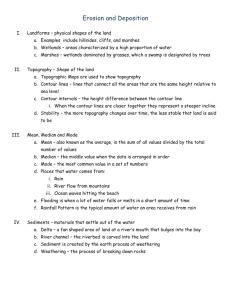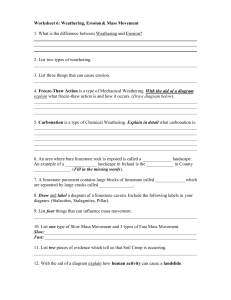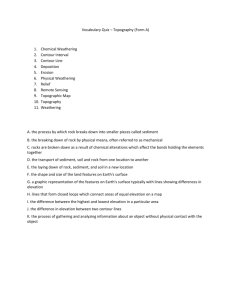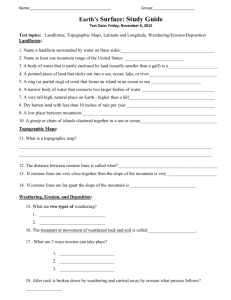GLS210_FR - Salem State University
advertisement
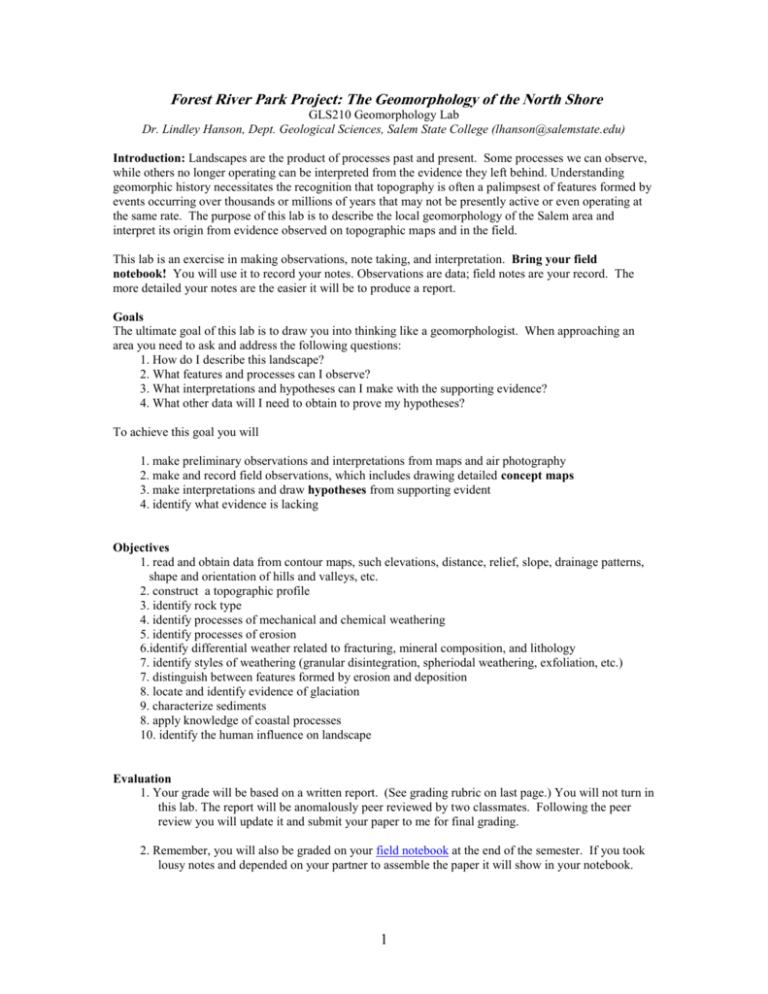
Forest River Park Project: The Geomorphology of the North Shore GLS210 Geomorphology Lab Dr. Lindley Hanson, Dept. Geological Sciences, Salem State College (lhanson@salemstate.edu) Introduction: Landscapes are the product of processes past and present. Some processes we can observe, while others no longer operating can be interpreted from the evidence they left behind. Understanding geomorphic history necessitates the recognition that topography is often a palimpsest of features formed by events occurring over thousands or millions of years that may not be presently active or even operating at the same rate. The purpose of this lab is to describe the local geomorphology of the Salem area and interpret its origin from evidence observed on topographic maps and in the field. This lab is an exercise in making observations, note taking, and interpretation. Bring your field notebook! You will use it to record your notes. Observations are data; field notes are your record. The more detailed your notes are the easier it will be to produce a report. Goals The ultimate goal of this lab is to draw you into thinking like a geomorphologist. When approaching an area you need to ask and address the following questions: 1. How do I describe this landscape? 2. What features and processes can I observe? 3. What interpretations and hypotheses can I make with the supporting evidence? 4. What other data will I need to obtain to prove my hypotheses? To achieve this goal you will 1. make preliminary observations and interpretations from maps and air photography 2. make and record field observations, which includes drawing detailed concept maps 3. make interpretations and draw hypotheses from supporting evident 4. identify what evidence is lacking Objectives 1. read and obtain data from contour maps, such elevations, distance, relief, slope, drainage patterns, shape and orientation of hills and valleys, etc. 2. construct a topographic profile 3. identify rock type 4. identify processes of mechanical and chemical weathering 5. identify processes of erosion 6.identify differential weather related to fracturing, mineral composition, and lithology 7. identify styles of weathering (granular disintegration, spheriodal weathering, exfoliation, etc.) 7. distinguish between features formed by erosion and deposition 8. locate and identify evidence of glaciation 9. characterize sediments 8. apply knowledge of coastal processes 10. identify the human influence on landscape Evaluation 1. Your grade will be based on a written report. (See grading rubric on last page.) You will not turn in this lab. The report will be anomalously peer reviewed by two classmates. Following the peer review you will update it and submit your paper to me for final grading. 2. Remember, you will also be graded on your field notebook at the end of the semester. If you took lousy notes and depended on your partner to assemble the paper it will show in your notebook. 1 Preparation: Read this lab. Review in your GLS100 text or you lab manual the following: unconformities, weathering, features formed by brittle deformation, igneous rocks, glacial abrasion, beaches and coastal processes, and characteristics of sediment. What to bring: Bring this lab, a clipboard, field notebook, compass, pencil, and erasure. A digital camera is suggested. However, photos must be recorded in you notebook. (It helps to activate the date stamp on your camera.) Instructions: The lab is divided into four parts that include map interpretation, fieldwork, synthesis and writing. For parts I-III you will complete everything individually. You will complete the final paper (Part IV) with a partner of my choice. Share, explain, and evaluate your data with your partner before writing your report. You will have time on your own to return to the site to fill in any gaps in your data. Type and submit (word 6 compatible or RTF) a 1000-word paper discussing the local landscape. Include concept maps for figures and photos if taken. All figures must have captions and must be cited and discussed in the text. No fillers please. If you take good notes writing your report will not be difficult. While in the field, listen, discuss, take notes, draw pictures, make observations and ask questions. Be proactive and thorough. Everyone should be putting in equal effort. Note: 1. My role is a facilitator. I will not spoon-feed you answers. This approach is difficult for me--it’s much easier to explain everything than to watch you founder, which can also be more time consuming. However, providing answers does not encourage thinking. If you have a specific question I will do my best to lead you in the right direction, however you must record your observations and make the final interpretation. 2. Answering questions on the lab: At this stage you may not be able to answer all the questions posed. If you can’t answer a specific question ask yourself why. Note what you need to learn or gather in order to obtain an answer. You may need to return to your text, have me clarify information, discuss it with a classmate, or investigate the area further. 2 Part I: Interpreting topography from contour maps A good geologist does not go into a field area blind, but first evaluates it by studying maps and air photographs. (You will have access to a more readable map in the lab and online, and can expore the area using Google Earth) Before continuing on lets review what you know about topographic maps: Figure 3.Contour map of the Salem Quadrangle. What is a Topographic map? Topographic maps illustrate 3-D topography on a 2-D sheet of paper. Topography can be represented either by shading or contouring elevation data. Shaded relief maps are easier to visualize, but less detailed and harder to plot and retrieve data from than contour maps. In this lab you will learn to read contour maps Terms Contour: a line connecting points of equal elevation. Contour interval: The elevation difference between contours Map Scale: The length on the map that is equal to a given distance on the ground. Elevation: height above mean sea level. Relief: Difference between the highest and lowest elevation. Height: relief of a feature. Measured from the base to the top. Rules of contours: 1. By definition contours connect points of equal elevation. 2. Contour don't join or cross unless a vertical cliff or an overhang (very rare) is indicated. 3. All points enclosed within an unhachured contour are of a higher elevation. 4. All points enclosed within a hachured contour are of a lower elevation 5. Contours crossing streams V upstream (upslope) 6. Contours crossing ridges between streams V downstream (downslope). 7. The spacing of contours indicates relative slope. A. Study the map of the Salem area and answer the following questions: 3 1. Map properties: a. Scale: State the relative fraction scale ______________ and the verbal scale in inches/mile using the bar scale _______________. (Don’t forget to state the units.) b. In a sentence state the meaning of the fractional scale: c. Identify the contour interval:___________ meters d. Determine the following (don’t forget to record the units.) i. highest elevation: ________ ii. lowest elevation: ________ iii. relief: ________ 2. Describe the landscape: Are the highlands flat-topped or rounded, are hills rounded or elongate, are they symmetrical or asymmetrical, is there any preferred orientation, etc? How about the lowlands and valleys? Is the area well drained? Are the drainages systems well defined? If not why? Was this landscape formed by erosion or deposition? What is your supporting evidence? Are there any modifications of the landscape by man? Approximately what percentage of the lands surface and coastline appear modified by man? Is the coastline straight or irregular? Are there any other features of the landscape not mentioned? 3. Construct a profile along line AB using a vertical exaggeration of 4x. Describe what the profile illustrates. (Graph paper generated by Incompetech.com. If you need more you can create it from here.) 4. Ask three questions about the topography that you would like to find out in the field. a. 4 b. c. 5 Part II: Forest River Field Trip – What do you see? During the field trip to Forest River we will see several examples of concepts and processes covered in Physical Geology. We will stop at four locations where you will be requested to make observations, draw concept maps, and then relate what you see to the regional geomorphology. In structural geology there is a generalization called Pumpelly’s Law that states that minor folds within a structure mimic the major fold structure within the same area. Due to the fractal nature of landscapes a similar generalization can sometimes be made about landforms. Small features can be a reflection of larger landforms. Stop 1. Introduction to geomorphic processes 1a. Before looking at the exposure at stop 1 look at the park landscape. Describe what you see. 1b. What is the type of rock underlying the park? What is the evidence? Is homogenous or variable? 1c. What geologic structures do you see? 1d. Explain why this outcrop is not uniformly eroded. What do you think is responsible for the local variations in erosion rates? For example what controls the location of the small valleys and why. 1e.The style of disintegration refers to the manner in which a rock breaks up and decomposes. Texture, mineralogy, external forces, climate, and time govern the various styles of disintegration--such as flaking, exfoliation, spheroid weathering, granular disintegration, joint-block separation, etc. Locate, identify, describe and discuss the processes involved in two styles of visible here. The Unconformity On the path leading down to the outcrop at stop 1 we walk over the unconformity between the Salem Gabbro-Diorite and the overlying sediment. 1f. Is this unconformity a disconformity, nonconformity or angular unconformity? Sketch and explain. 1g. What process is recorded by this unconformity? What process is largely responsible for the landforms that you see? 1h. Record your observations by drawing a concept sketch of the exposure. Channel formation by headward erosion The path leading to the outcrop on at stop 1 has turned into a channel, which is lengthening through headward erosion. 1i. Sketch a profile of the channel. 1k. In which direction is the channel growing? 1j. hypothesize the processes leading to the formation and enlargement of the channel. 1l. What is controlling the channel’s depth of erosion? 6 Stop 2. Pocket Beach. A small beach located in a cove between two headlands is called a pocket beach. Pocket beaches are typically found along glaciated coasts and obtain their sediment from the erosion of adjacent headlands, offshore sources, and/or erosion of the back-beach area. Grain size and rounding of beach clasts are a function of distance traveled, wave energy, and length of exposure. 2a. In your notebook draw a concept sketch of the beach, backshore and headlands. Label features and annotate your sketch to answer or explain the following: i. the shape of the beach. ii. the composition of the beach iii. the nature of the sediment (coarse or fine, angular or rounded, well- or poorly-sorted, etc.) and any pattern to the distribution of sediment. iv. the material eroding from the backshore v. the headlands and their composition vi. the processes responsible for forming the beach vii. Is this a sheltered or high energy beach? What’s the evidence? Note: make sure your sketch has a scale and north arrow 2b. Hypothesize how the beach was formed and cite your evidence. 2c. Glaciers both deposit and erode, but not uniformly. The arm of Cape Cod is composed of glacial moraines created when retreating lobes of ice halted long enough for sediment to accumulate along their margins. No such deposits are found here in the North Shore. Instead the region was aerially scoured and blanketed with a thin discontinuous layer of ground moraine. The (outwash) moraine of the outer Cape has been eroded back several thousand feet and straightened by wave activity. The shape of the coast along Cape Cod therefore reflects present processes. Explain why the coast of the North Shore has not been similarly affected by wave activity in the last 12,000 years since deglaciation? What does this tell you about lagtime and factors controlling the permanence of landforms? 2d. There are two sandy beaches at Forest River Park. Describe the sand. Does the sand reflect any local source of sediment? If not, where did it come from? 7 Stop 3. Bedrock Outcrop on west shore Differential weathering and erosion Differential weathering and erosion occurs where rocks exposed to similar conditions are broken down and removed at different rates. It may be caused by variations in structure, degree of fracturing, rock texture, or mineral stability. 3a. Identify and describe two examples of differential weathering visible in this outcrop. 3b. Does the progression of chemical weathering exhibited in these rocks reflect the Goldich sequence? Discuss. 3d. In your notebook draw a concept map illustrating the process of differential weathering and erosion responsible for forming valleys. Signs of glaciation The last ice sheet to cover the North Shore retreated only 12,000 years ago. Weathering has removed most obvious signs of glacial scouring, such as polished rock surfaces, glacial grooves and striations. Nevertheless, fresh striations and other glacial features are visible near the waterline. 3e. Near the low-tide waterline is a polished bedrock knob. Make a concept sketch of the feature. Note the orientation of the stoss (gentle abraided) and lee (steep plucked) sides. What is this feature? 3f. Explain how it formed? (This I will tell you. So listen, and take notes.) 3g. What direction of movement is recorded? Was the glacier warm- or cold-based? What is the evidence? 3h. Look around, locate and describe any other evidence of glacial scouring. 3i. Develop a hypothesis explaining why glacial features are better preserved along the waterline than further up on the outcrop. Include supporting evidence. What controls the preservation of glacial features? 3j. Were these features formed when the glacier was advancing and growing or thinning and retreating? How do you know? Is there any further evidence that can be obtained to determine this? 8 Part III – Revisit the Map 1. Discuss which questions asked in Part I that you are now able to answer. 2. Discuss what you now understand that you didn’t before. Part IV to be submitted. Write a paper about the local landscape. 1. Include: a. a header with title (be creative), name and affiliation (Dept. of Geological Sciences, Salem State College) and date. b. a clear description of the landscape. c. a discussion of the roles of lithology, structure, differential erosion, glaciation, and man in shaping the present landscape. Use the following *terms and concepts in a way that indicates that you clearly understand their meaning and significance to the topic: Bedrock, igneous, faults and joints, differential weathering, glacial scouring, linear valleys, deranged drainage, glaciation, roche moutonnee, asymmetrical, differential weathering and erosion, relief, pocket beaches, and fill. You are not restricted to these. 9 d. Images: Choose three carefully selected images that clearly illustrate points discussed in your paper. Each image must have a numbered figure caption (Figure 1, Figure 2, etc.) and explanation. Figures must be cited in the text of the report. 2. Your paper must follow a logical progression and contain well-organized paragraphs. The first sentence introduces the reader to the topic of that paragraph. Do not repeat information across several paragraphs or randomly hop from one topic to the next. 3. Do not write a step-by-step outline of this lab. 10 Grading Rubric For North Shore/Forest River Project Points Criteria 3 Points earned 0 1, 2,3 Prose: Requires good: b. paragraph structure c. syntax d. spelling e. continuity Unreadible. Can not follow or understand what is being said. Readible, except for: 4 Well written and clear. (circle all that are appropriate) (Do not go further. High-light problem areas and return to be rewritten) 4 0 1, 2, 3 4 Description of landscape not discussed incomplete all aspects clearly covered 1, 2, 3, 4 5, 6, 7, 8, 9 10 mostly incomplete (indicate what is missing or not well described) incomplete (indicate what is missing or not well described) the role of each factor are clearly discussed with supporting evidence (relief, general topography, hills and valleys, symmetry of slopes, coastline, drainage, human influence, etc) 4 Identified and interpreted the evidence and role of: a. lithology and structure c. weathering and erosion d. glaciation e. coastal processes f. man Additional Criteria Subtract one point for each of the following: a. incomplete header b. no figures or incomplete concept sketches c. no figure captions d. figures are not cited in text. e. each *term not correctly introduced f. terms and concepts outlined in part 1c above are not incuded or discussed Comments: Total: 11
